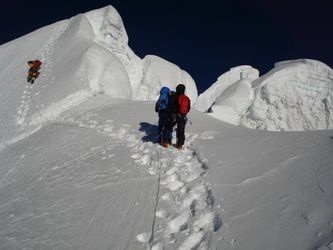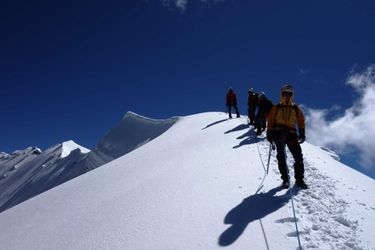Climbing Lobuche east





Lobuche East, located in Nepal, stands at an impressive height of 6,119 meters. It's a mountain that offers a challenging yet rewarding climb for those looking to push their limits. The ascent is typically approached from the south ridge, which requires a mix of technical skills due to its steep and icy sections. The route is known for its breathtaking views of the surrounding peaks, including Ama Dablam and Pumori, making it a favorite among climbers seeking both adventure and scenic beauty.
The difficulty of Lobuche East should not be underestimated. Its summit ridge is sharp and requires careful navigation, especially in adverse weather conditions. The climb demands proficiency in the use of crampons and ice axes, as well as experience with fixed ropes. The high altitude and exposure can be taxing, even for seasoned climbers. It's crucial to be prepared for sudden weather changes and to acclimatize appropriately, as altitude sickness is a common concern.
When planning an expedition to Lobuche East, it's worth noting that there are numerous logistical considerations, from obtaining permits to organizing gear and supplies. Fortunately, there are 39 guides who offer expeditions to this remarkable peak. Their expertise can be invaluable, ensuring both safety and a successful summit attempt.
Table of contents
Route
- 3,279 m gain over 18 days
- Starting and ending in Lukla
- approach: walk in
Walk in
- +2,100 m over a 60 km approach
- 7 - 9 days in
- 3 - 5 days out
Climb
- +1,229 m over 2 days.
- 1 high camp. There is one high camp at around 5400m which is typically used.
Difficulty
- PD: Not very hard (alpine grade 2)
- AD: Fairly hard (alpine grade 3)
When to go
- April and May
- October and November
Permits
- 3 permits are needed
- costing around $224 total
Guide mandatory?
- no
These are pictures taken while climbing Lobuche east. They're shown here to give you an idea of what the route is like. You're welcome to share your own pictures of climbing Lobuche east, to help the community of climbers. Picture here are either uploaded by members (their own, or creative commons pictures), or guides.
Guide links
Lobuche east History
Climbing history of Lobuche east
The history of Lobuche East is intertwined with the traditions and culture of the Sherpa people who inhabit the Khumbu region of Nepal. This area is known for its rich cultural heritage and the Sherpa community's profound connection to the mountains.
While the exact details of the earliest summit attempts on Lobuche East are not extensively documented, the mountain has been a destination for climbers seeking to challenge themselves in the Himalayas. Its proximity to Everest and the popular trekking route to Everest Base Camp has made Lobuche East a prominent feature in the landscape of mountaineering history. Over the years, it has attracted climbers from around the world, drawn by the allure of its challenging ridges and the breathtaking views it offers from its summit.
 Lobuche Base Camp
Lobuche Base Camp
 High Camp
High Camp
 Lobuche East Summit
Lobuche East Summit
Lobuche east weather
How is the weather on Lobuche east, and when is the best time to go.
The best time to climb Lobuche East is during the spring (March to May) and autumn (September to November) seasons. During these months, the weather is relatively stable and dry, making it easier to climb. However, be prepared for cold temperatures and occasional snowfall at higher elevations.
The best time to climb Lobuche east is in these months:
- Apr
- May
- Oct
- Nov
Lobuche east Gear Packing List
What To Take to climb Lobuche east
- Sleeping bag (-20°C)
- Backpack (50-60 liters)
- Daypack (30 liters)
- Headlamp with extra batteries
- Water bottles (2-3 liters total capacity)
- Pee bottle (1-2 liters)
- Waterproof stuff sacks (for sleeping bag, clothes, etc.)
- Multi-tool or knife
- Sunscreen (SPF 50+)
- Lip balm with SPF
- Personal first aid kit (including blister treatment, ibuprofen, and any personal medications)
- Electrolyte tablets
- Wet wipes
- Toilet paper (1 roll)
- Hand sanitizer
- Snacks (energy bars, chocolate, etc.)
- Insulated jacket (down or synthetic)
- Hardshell jacket (waterproof and breathable)
- Hardshell pants (waterproof and breathable)
- Softshell jacket (breathable)
- Softshell pants (breathable)
- Fleece jacket or pullover
- Thermal base layer top and bottom (synthetic or wool)
- Warm hat (synthetic or wool)
- Balaclava (synthetic or wool)
- Buff or neck gaiter
- Warm gloves (2 pairs)
- Warm mittens (1 pair)
- Mountaineering boots (double plastic or insulated leather)
- Climbing harness
- Climbing helmet
- Crampons (with antiballing plates)
- Ice axe
- Trekking poles
- Gaiters
- Sunglasses with UV protection
- Rope (50-60 meters)
- Carabiners (6-8)
- Ice screws (4-6)
- Prusik cords (2)
- Slings (3-4)
- Ascender (1)
- Descender (1)
- Personal anchor system (1)
- Camera with extra batteries and memory cards
- Portable charger
- Book or e-reader
- Music player with earphones
- Playing cards or other small games
Lobuche east Services
Gear rental, porters, guides, transport, internet, accommodation
Accommodation
Teahouses are available along the route offering basic accommodations with shared bathrooms.Food
Food is available on the route, mostly basic meals such as rice, lentils, and vegetables, with some Western options as well.Guides
Guides are available and it's recommended to hire one, costing around $25-30 per day.Porters
Porters are also available for hire, costing around $15-20 per day for carrying up to 30kg of load.Medical facilities
There are basic medical services available at some villages on the route, but it's recommended to bring your own first-aid kit.Gear rental
Equipment can be rented in Kathmandu, including sleeping bags, down jackets, and trekking poles. It's recommended to bring your own climbing gear.Transport
The trek usually starts and ends in Lukla, which can be reached by a short flight from Kathmandu. Private transportation can be arranged as well.Internet / Phone
Connectivity is limited along the route, with spotty phone signal and occasional access to wifi at some teahouses. It's recommended to bring a satellite phone if you need to stay connected.ATMs
There are no ATMs along the route, so it's recommended to bring enough cash for the trek.Shops
There are small shops along the route, selling basic items like snacks, drinks, and trekking gear.Lobuche east permits
What permits are needed for climbing Lobuche east
1. Sagarmatha National Park entry permit
- $30 (~3,395 in the local currency)
- Required for entry into Sagarmatha National Park
- Can be obtained in advance or in-person at the entry gate
2. Khumbu Pasang Lhamu Rural Municipality permit
- $18 (~2,000 in the local currency)
- Required for entry into the Khumbu region
- Can be obtained in advance or in-person at the municipality office in Namche Bazaar
3. Lobuche East climbing permit
- $176 (~20,000 in the local currency)
- Required for climbing Lobuche East
- Can be obtained in advance or in-person at the Nepal Mountaineering Association office in Kathmandu or on-site in Lobuche
Lobuche east access - getting there
How to get to Lobuche east
- Flight: The most common way to reach the starting point of the Lobuche east climb is by taking a flight from Kathmandu to Lukla airport.
- Helicopter: Another option is to hire a helicopter from Kathmandu to Lukla or directly to the starting point of the trek.
- Bus: From Kathmandu, you can take a bus to Jiri and start the trek from there.
- Taxi/Jeep: It's also possible to hire a taxi or jeep to reach the starting point of the trek from Kathmandu or other nearby cities.
- Trek: For those who prefer a more adventurous approach, it's possible to trek to the starting point from Lukla or Jiri.
These are variations on the typical route. Which could be added on; either part way along or at the start / end to extend the trek.
Kongma La Pass
add 1 extra day
Lobuche east questions
What to know about climbing Lobuche east
Common questions people have about this trek, if yours isn’t here - add it to get an answer.
These climbs are similar in length, difficulty, and elevation. Offering a similar level of challenge as the Lobuche east climb.




